Hollow-Core FRP–Concrete–Steel Bridge Columns under Torsional Loading
Abstract
:1. Introduction
2. Research Significance
3. Experimental Program
3.1. Test Specimen
3.2. Material Properties
3.3. Experimental Setup and Instrumentation
3.4. Measuring of the Column Twist Angle
3.5. Loading Protocol
4. Results and Discussion
4.1. General Behavior
4.2. Relative Sliding of GFRP Tube and Steel Tube
4.3. Strain Profile
4.4. Comparison of Torsional Behavior with RC Column from Previous Studies
5. Summary and Conclusions
- The torsional behavior of the HC-FCS column depended on the steel tube’s stiffness and the friction existing between the column’s components.
- The stiffness of the HC-FCS column was maintained even at large twists, and exhibited good ductility.
- The direct contribution of the GFRP tube towards the torque was negligible.
- The HC-FCS column was able to sustain its torque strength along twist angles significantly higher than those of the comparable reinforced concrete columns. The reinforced concrete columns displayed a significant reduction in its torque capacities starting at twist angle of 3°, whereas the HC-FCS column maintained its strength until a twist angle of 7°.
Acknowledgments
Author Contributions
Conflicts of Interest
References
- Dawood, H.; ElGawady, M.A.; Hewes, J. Factors affecting the seismic behavior of segmental precast bridge columns. Front. Struct. Civ. Eng. J. 2014, 8, 388–398. [Google Scholar] [CrossRef]
- Abdelkarim, O.I.; ElGawady, M.A. Analytical and finite-element modeling of FRP-concrete-steel double-skin tubular columns. J. Bridge Eng. 2014, 20, B4014005. [Google Scholar] [CrossRef]
- Mirmiran, A.; Shahawy, M. A new concrete-filled hollow FRP composite column. Compos. Part B Eng. 1996, 27, 263–268. [Google Scholar] [CrossRef]
- Youssf, O.; ElGawady, M.A.; Mills, J. Finite element modelling and dilation of FRP-confined concrete columns. Eng. Struct. 2014, 79, 70–85. [Google Scholar] [CrossRef]
- Youssf, O.; ElGawady, M.A.; Mills, J. Static cyclic behaviour of FRP-confined crumb rubber concrete columns. Eng. Struct. 2016, 113, 371–387. [Google Scholar] [CrossRef]
- Abdelkarim, O.I.; ElGawady, M.A. Dynamic and static behavior of hollow-core FRP-concrete-steel and reinforced concrete bridge columns under vehicle collision. Polymers 2016, 8, 432. [Google Scholar] [CrossRef]
- Abdelkarim, O.I.; ElGawady, M.A. Behavior of hollow FRP-concrete-steel columns under static cyclic axial compressive loading. Eng. Struct. 2016, 123, 77–88. [Google Scholar] [CrossRef]
- Ozbakkaloglu, T. Axial compressive behavior of square and rectangular high-strength concrete-filled FRP Tubes. J. Compos. Constr. 2012, 17, 151–161. [Google Scholar] [CrossRef]
- Mirmiran, A.; Mohsen, S.; Thomas, B. Slenderness limit for hybrid FRP-concrete columns. J. Compos. Constr. 2001, 5, 26–34. [Google Scholar] [CrossRef]
- Lam, L.; Teng, J.G. Ultimate condition of fiber reinforced polymer-confined concrete. J. Compos. Constr. 2004, 8, 539–548. [Google Scholar] [CrossRef]
- Abdelkarim, O.I.; ElGawady, M.A. Concrete-filled-large deformable FRP tubular columns under axial compressive loading. Fibers 2015, 3, 432–449. [Google Scholar] [CrossRef]
- Montague, P. Experimental behavior of double-skinned, composite, circular cylindrical-shells under external-pressure. J. Mech. Eng. Sci. 1978, 20, 21–34. [Google Scholar] [CrossRef]
- Teng, J.G.; Yu, T.; Wong, Y.L. Behavior of hybrid FRP-concrete-steel double-skin tubular columns. In Proceedings of the 2nd International Conference on FRP Composites in Civil Engineering, Adelaide, Australia, 8–10 December 2004; pp. 811–818. [Google Scholar]
- Teng, J.G.; Yu, T.; Wong, Y.L.; Dong, S.L. Hybrid FRP concrete-steel tubular columns: Concept and behavior. Constr. Build. Mater. 2007, 21, 846–854. [Google Scholar] [CrossRef]
- Abdelkarim, O.I.; ElGawady, M.A.; Gheni, A.; Anumolu, S.; Abdulazeez, M. Seismic performance of innovative hollow-core FRP–concrete–steel bridge columns. J. Bridge Eng. 2016, 22, 04016120. [Google Scholar] [CrossRef]
- Yu, T.; Wong, Y.; Teng, J.; Dong, S.; Lam, E. Flexural behavior of hybrid FRP-concrete-steel double-skin tubular members. J. Compos. Constr. 2006, 10, 443–452. [Google Scholar] [CrossRef]
- Wong, Y.L.; Yu, T.; Teng, J.G.; Dong, S.L. Behavior of FRP-confined concrete in annular section columns. Compos. Part B Eng. 2008, 39, 451–466. [Google Scholar] [CrossRef]
- Ozbakkaloglu, T.; Akin, E. Behavior of FRP-confined normal-and high-strength concrete under cyclic axial compression. J. Compos. Constr. 2011, 16, 451–463. [Google Scholar] [CrossRef]
- Zhang, B.; Teng, J.G.; Yu, T. Experimental behavior of hybrid FRP–concrete–steel double-skin tubular columns under combined axial compression and cyclic lateral loading. Eng. Struct. 2015, 99, 214–231. [Google Scholar] [CrossRef]
- Moustafa, A.; ElGawady, M.A. Strain rate effect on properties of rubberized concrete confined with glass fiber–reinforced polymers. J. Compos. Constr. 2016, 20, 04016014:1–04016014:13. [Google Scholar] [CrossRef]
- Otuska, H.; Takeshita, E.; Yabuki, W.; Wang, Y.; Yoshimura, T.; Tsunomoto, M. Study on the seismic performance of reinforced concrete columns subjected to torsional moment, bending moment and axial force. In Proceedings of the 13th World Conference on Earthquake Engineering, Vancouver, BC, Canada, 1–6 August 2004. [Google Scholar]
- Prakash, S.S. Seismic behavior of circular reinforced concrete bridge columns under combined loading including torsion. Ph.D. Thesis, Missouri University of Science and Technology, Rolla, MO, USA, 2009. [Google Scholar]
- Beck, J.; Kiyomiya, O. Fundamental pure torsion properties of concrete filled circular steel tubes. J. Mater. Conc. Struct. Pavements 2003, 60, 85–96. [Google Scholar]
- Han, L.H.; Yao, G.H.; Tao, Z. Performance of concrete-filled thin-walled steel tubes subjected to pure torsion. Thin-Walled Struct. 2007, 45, 24–36. [Google Scholar] [CrossRef]
- Nie, J.G.; Wang, Y.H.; Fan, J.S. Experimental study on seismic behavior of concrete filled steel tube columns under pure torsion and compression–torsion cyclic load. J. Constr. Steel Res. 2012, 79, 115–126. [Google Scholar] [CrossRef]
- Huang, H.; Han, L.H.; Zhao, X. Investigation on concrete filled double skin steel tubes (CFDSTs) under pure torsion. J. Constr. Steel Res. 2013, 90, 221–234. [Google Scholar] [CrossRef]
- Anumolu, S.; Abdelkarim, O.I.; ElGawady, M.A. Behavior of hollow-core steel-concrete-steel columns subjected to torsion loading. J. Bridge Eng. 2016, 21, 04016070. [Google Scholar] [CrossRef]
- ASTM. Standard Test Method for Tensile Properties of Polymer Matrix Composite Materials; Standard D3039/D3039M; ASTM: West Conshohocken, PA, USA, 2014. [Google Scholar]
- ASTM. Standard Specification for Test Coupons for Steel Castings; Standard A1067; ASTM: West Conshohocken, PA, USA, 2012. [Google Scholar]
- Abdelkarim, O.; Gheni, A.; Anumolu, S.; ElGawady, M. Seismic behavior of hollow-core FRP-concrete-steel bridge columns. ASCE Struct. Congr. 2015, N/A, 585–596. [Google Scholar]
- FEMA. Interim Testing Protocols for Determining the Seismic Performance Characteristics of Structural and Nonstructural Components; FEMA 461; FEMA: Washington, DC, USA, 2007. [Google Scholar]
- Rousakis, T.C. Reusable and recyclable nonbonded composite tapes and ropes for concrete columns confinement. Compos. Part B Eng. 2016, 103, 15–22. [Google Scholar] [CrossRef]
- Rousakis, T.C.; Tourtouras, I.S. Modeling of passive and active external confinement of RC columns with elastic material. ZAMM J. Appl. Math. Mech. 2015, 95, 1046–1057. [Google Scholar] [CrossRef]
- Rousakis, T.C. Elastic fiber ropes of ultrahigh-extension capacity in strengthening of concrete through confinement. J. Mater. Civ. Eng. 2013, 26, 34–44. [Google Scholar] [CrossRef]
- Rousakis, T.C. Hybrid confinement of concrete by fiber-reinforced polymer sheets and fiber ropes under cyclic axial compressive loading. J. Compos. Constr. 2013, 17, 732–743. [Google Scholar] [CrossRef]

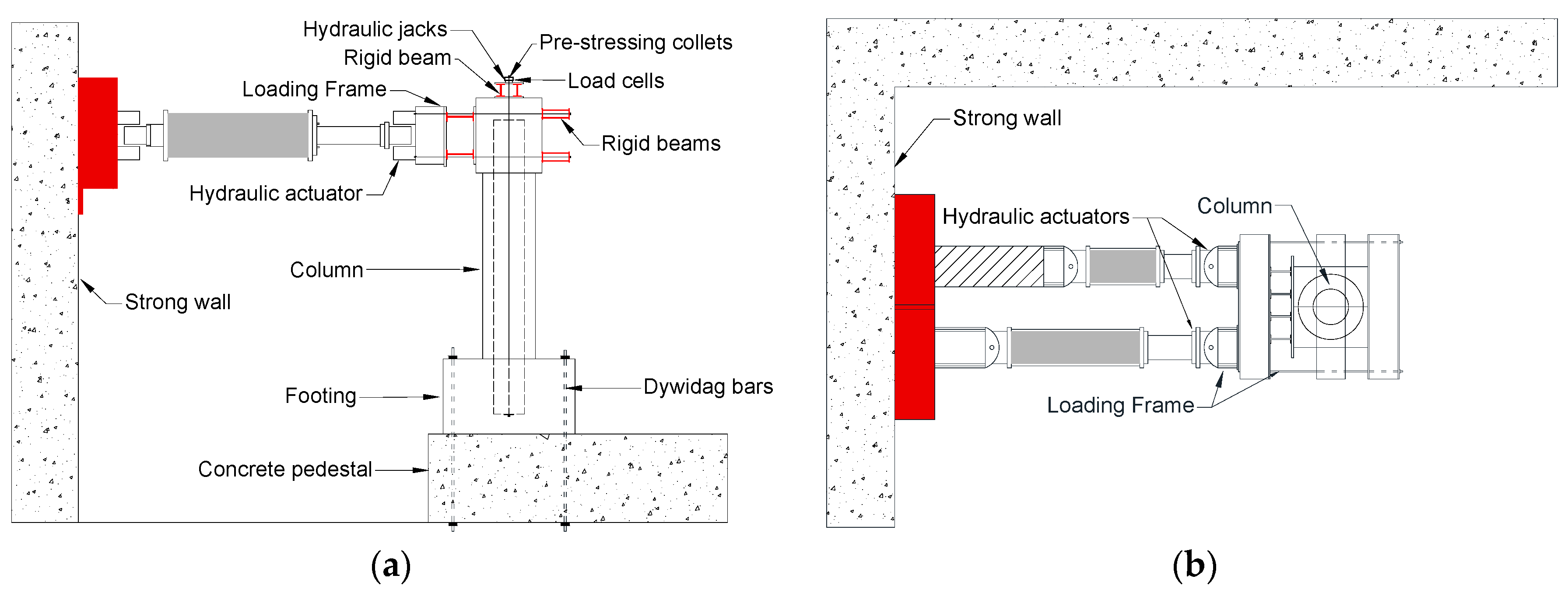
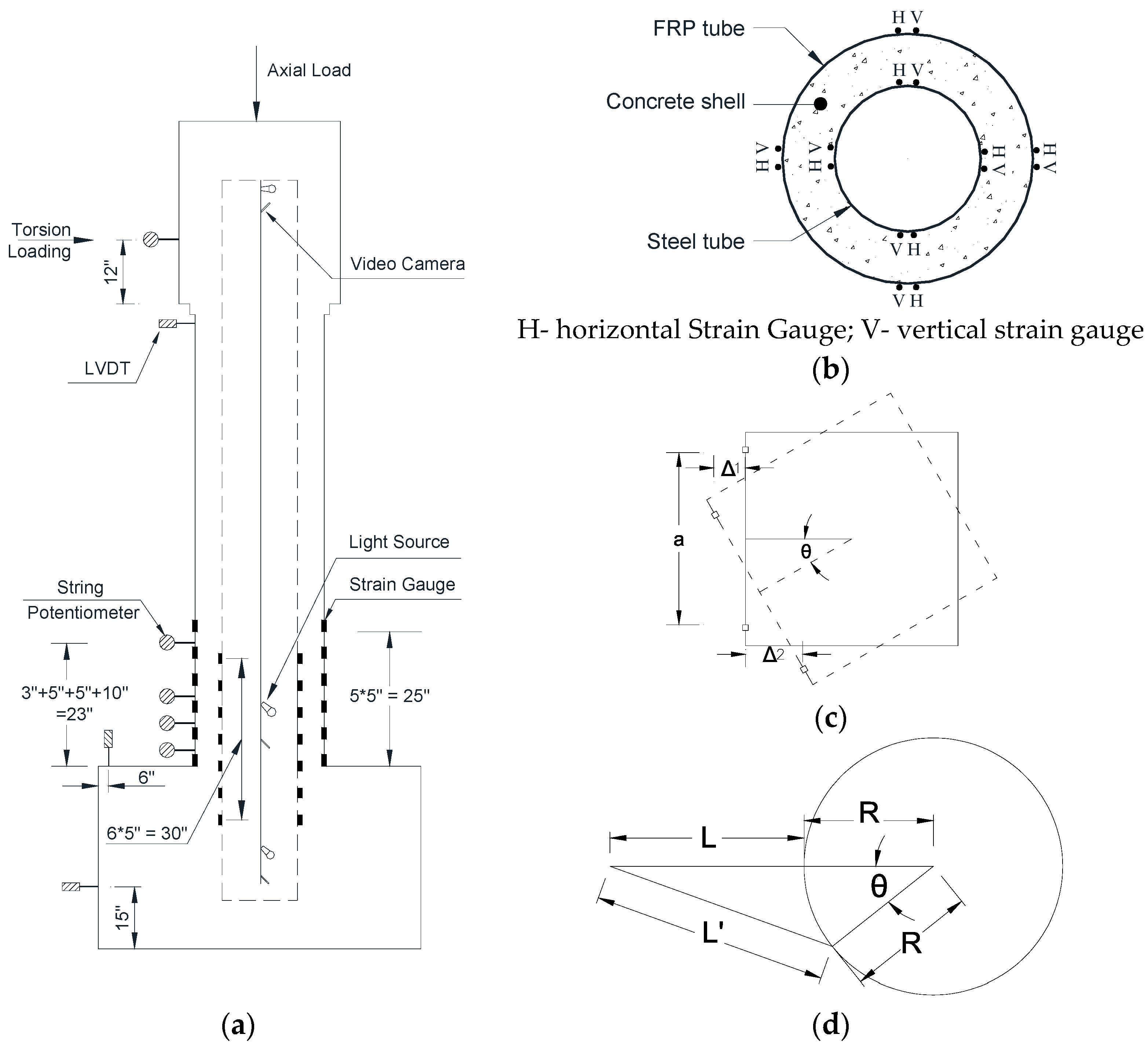
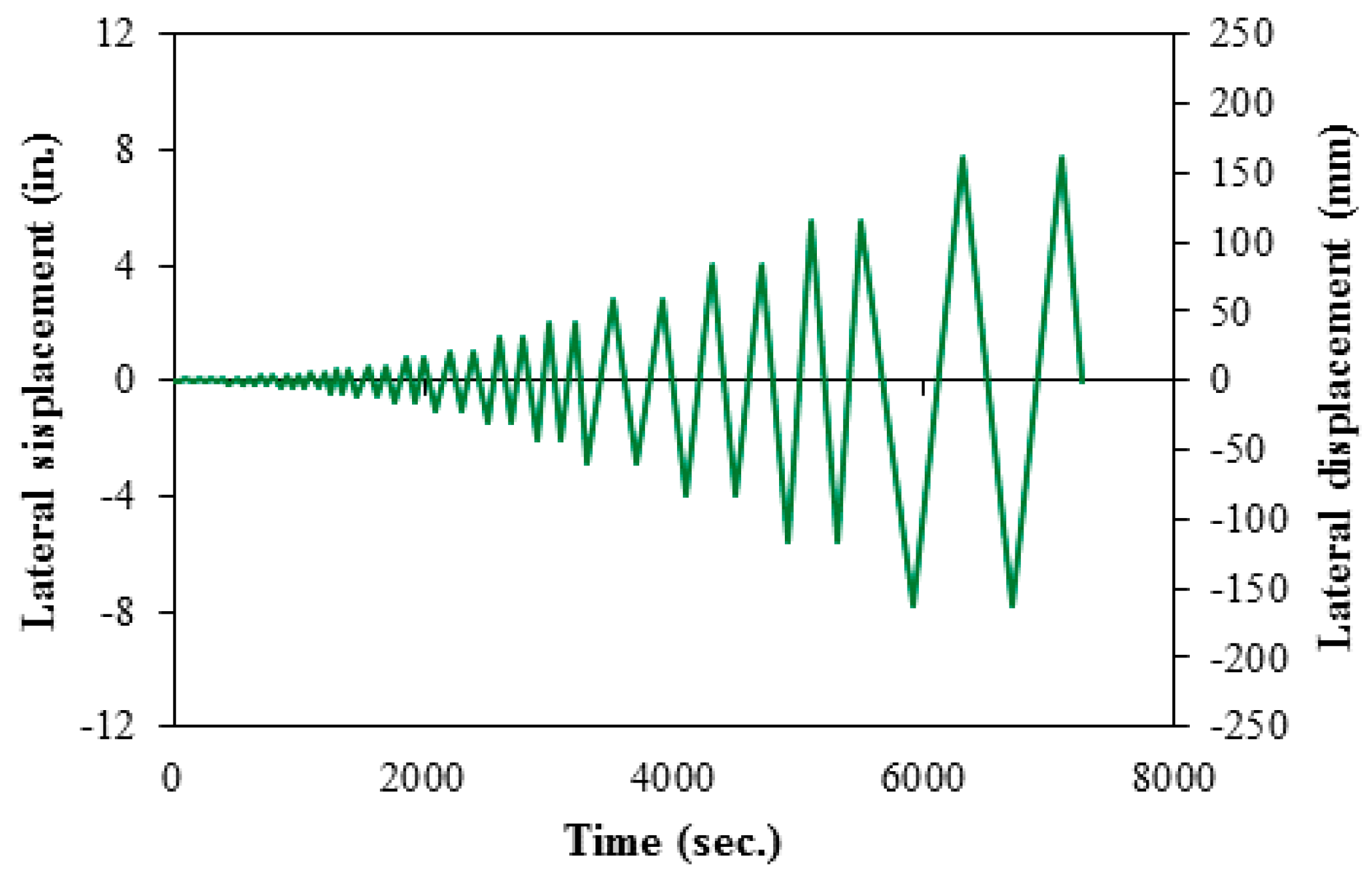


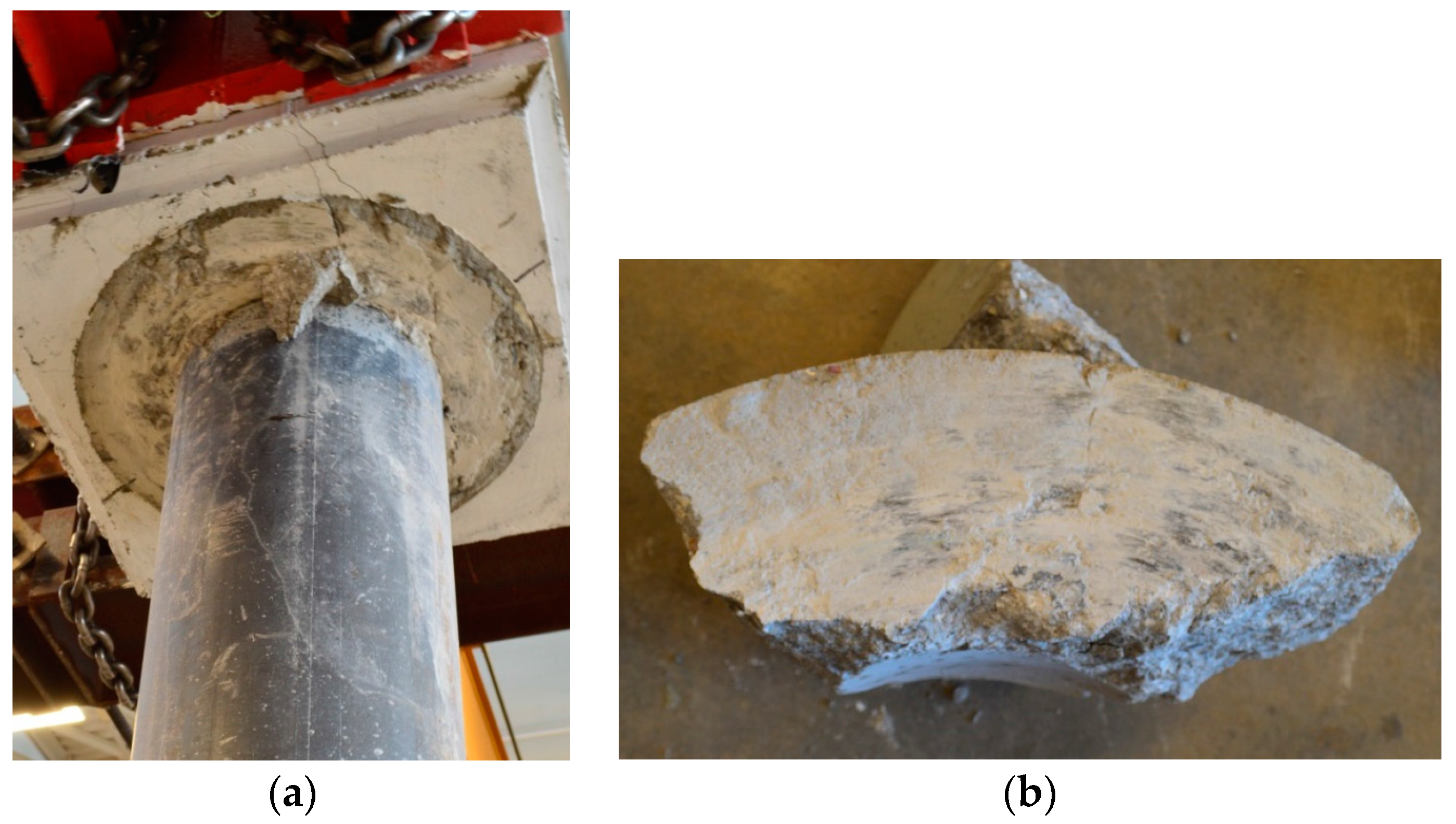
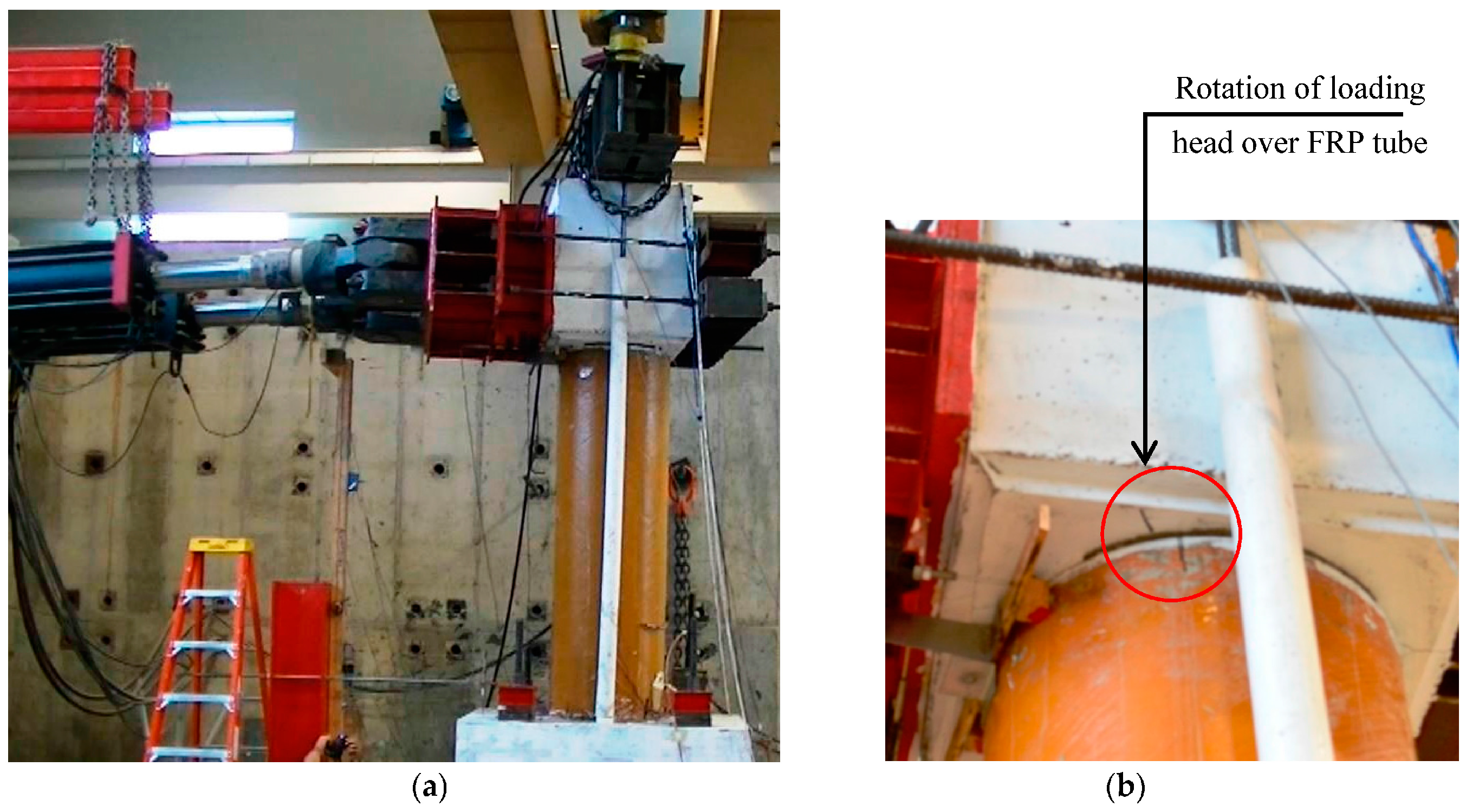
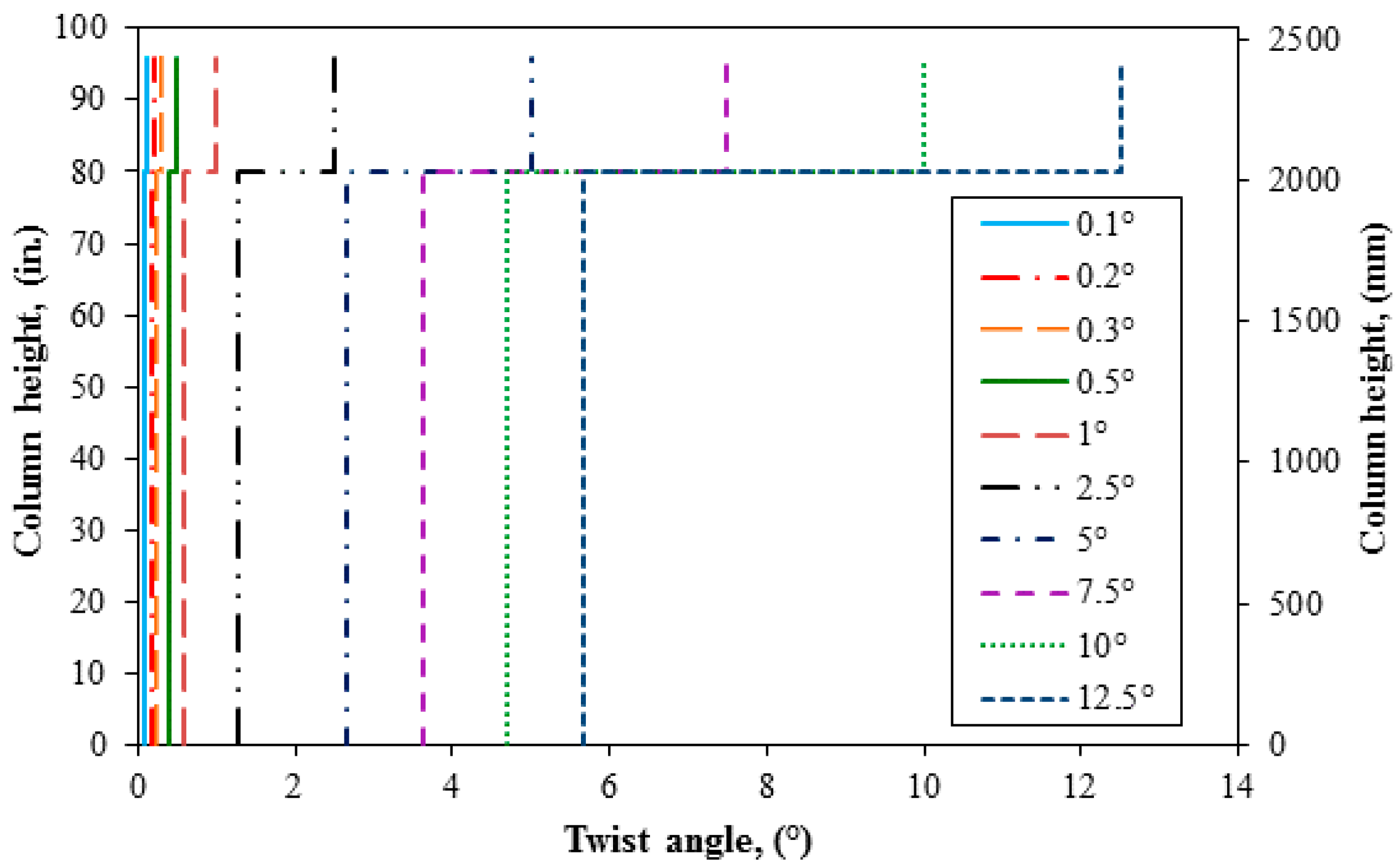

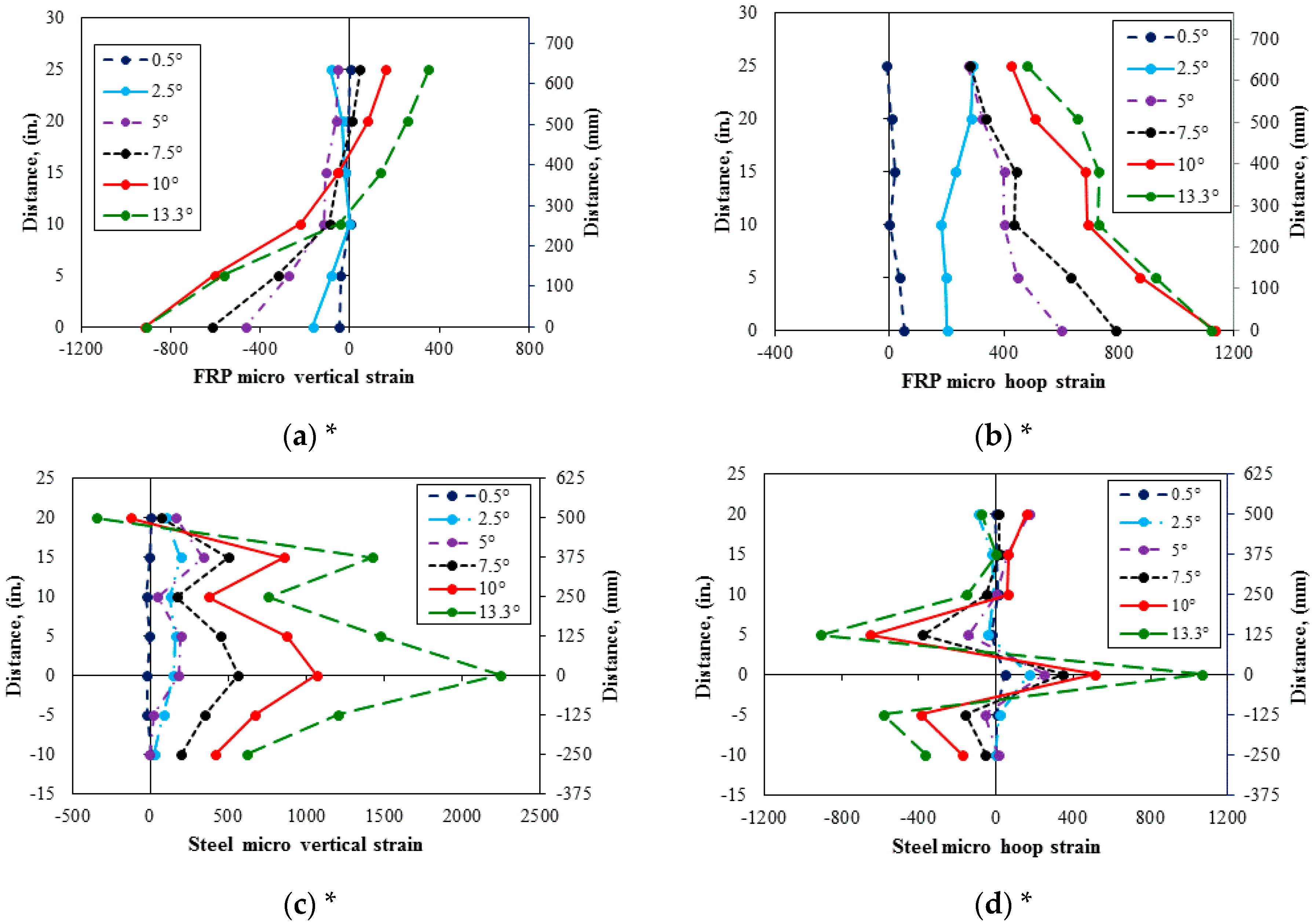
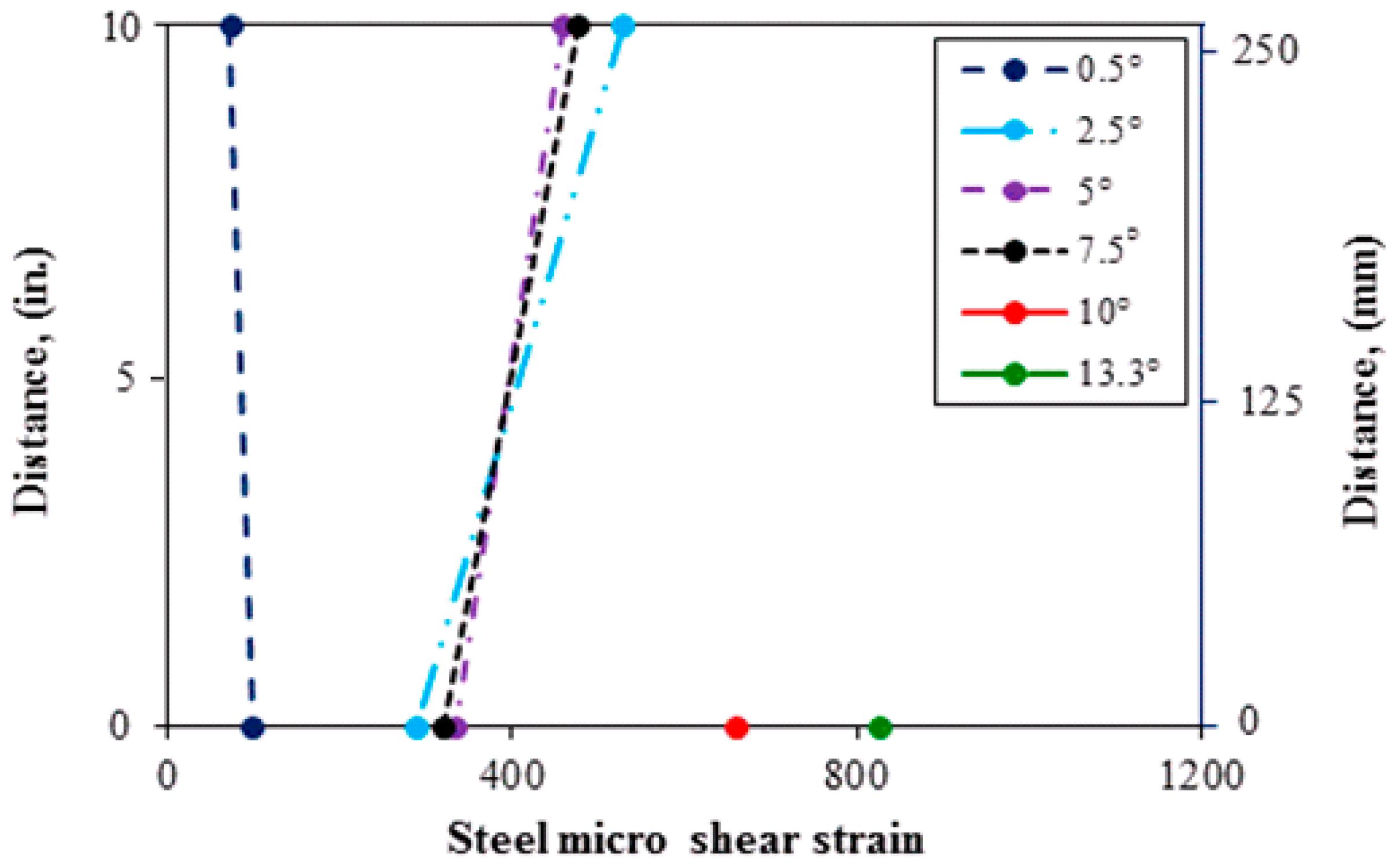
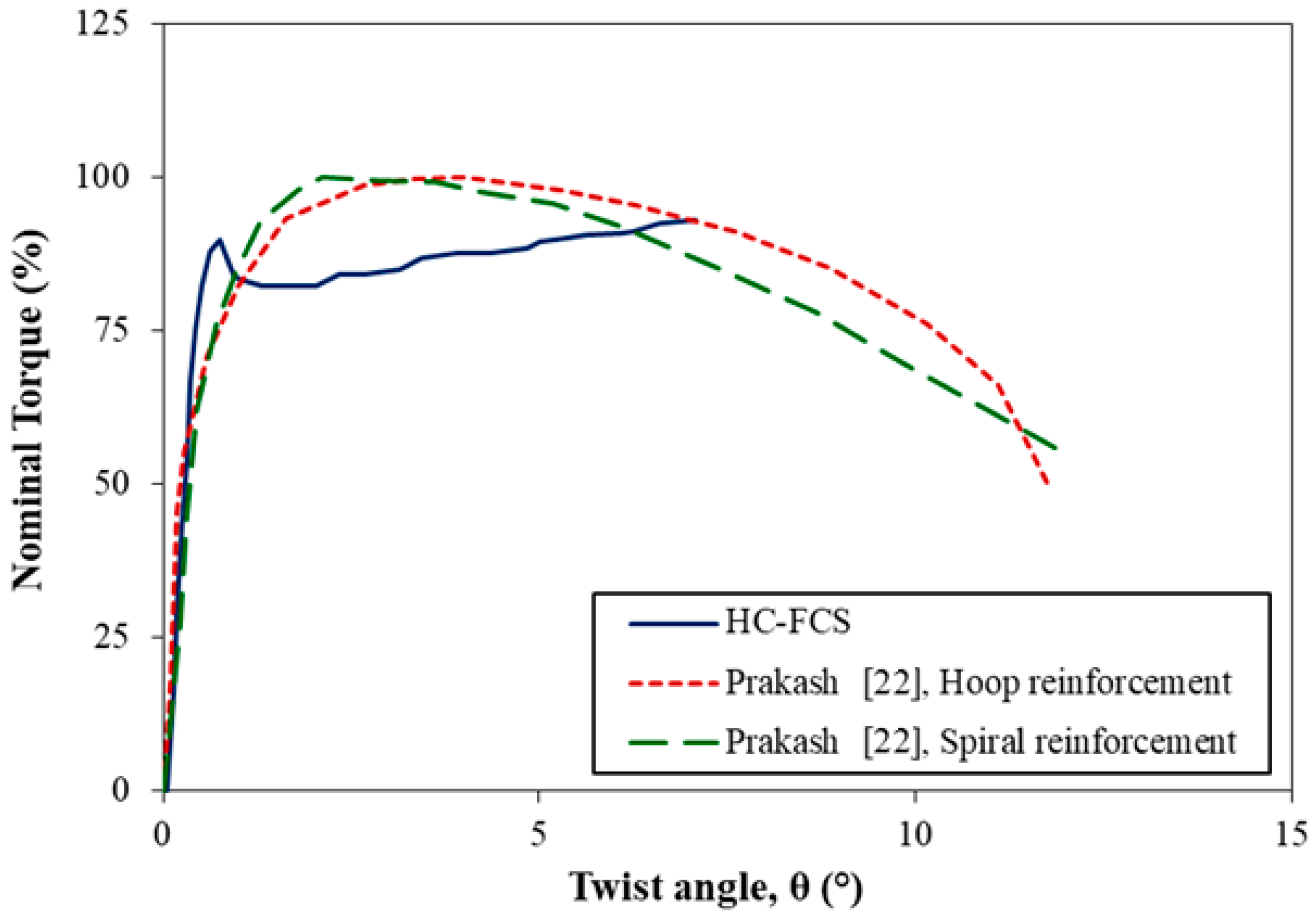
| Axial Compression Elastic Modulus, ksi (GPa) | Axial Ultimate Compressive Stress, psi (MPa) | Axial Tensile Elastic Modulus, ksi (GPa) | Axial Ultimate Tensile Stress, psi (MPa) | Hoop Elastic Modulus, ksi (GPa) | Hoop Rupture Stress, psi (MPa) |
|---|---|---|---|---|---|
| 677 (4.7) | 12,510 (83.8) | 1680 (11.6) | 9530 (65.7) | 3020 (20.8) | 40,150 (276.9) |
| Yield Stress, psi (MPa) | Yield Strain | Ultimate Stress, psi (MPa) | Rupture Strain |
|---|---|---|---|
| 47,000 (324) | 0.16% | 70,000 (483) | 19.0% |
| Cement, lb/yd3 (kg/m3) | Fly Ash, lb/yd3 (kg/m3) | Fine Aggregate, lb/yd3 (kg/m3) | Coarse Aggregate, lb/yd3 (kg/m3) | Water, lb/yd3 (kg/m3) | HRWR, lb/yd3 (kg/m3) | w/c Ratio |
|---|---|---|---|---|---|---|
| 590 | 170 | 1430 | 1430 | 380 | 1.9 | 0.5 |
| (350) | (101) | (848) | (848) | (225) | (1.13) |
| Property | Footing | Column |
|---|---|---|
| f’c, psi (MPa)—28 days | 9500 (65.5) | 5158 (35.5) |
| f’c, psi (MPa)—date of test | 9700 (66.9) | 6910 (51.0) |
© 2017 by the authors. Licensee MDPI, Basel, Switzerland. This article is an open access article distributed under the terms and conditions of the Creative Commons Attribution (CC BY) license (http://creativecommons.org/licenses/by/4.0/).
Share and Cite
Anumolu, S.; Abdelkarim, O.I.; Abdulazeez, M.M.; Gheni, A.; ElGawady, M.A. Hollow-Core FRP–Concrete–Steel Bridge Columns under Torsional Loading. Fibers 2017, 5, 44. https://doi.org/10.3390/fib5040044
Anumolu S, Abdelkarim OI, Abdulazeez MM, Gheni A, ElGawady MA. Hollow-Core FRP–Concrete–Steel Bridge Columns under Torsional Loading. Fibers. 2017; 5(4):44. https://doi.org/10.3390/fib5040044
Chicago/Turabian StyleAnumolu, Sujith, Omar I. Abdelkarim, Mohanad M. Abdulazeez, Ahmed Gheni, and Mohamed A. ElGawady. 2017. "Hollow-Core FRP–Concrete–Steel Bridge Columns under Torsional Loading" Fibers 5, no. 4: 44. https://doi.org/10.3390/fib5040044





